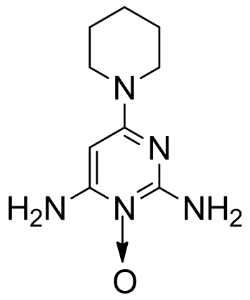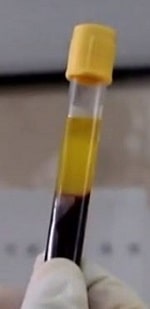How does Minoxidil work in growing hair on a receding hairline? I regularly update this post with newer studies discussing this topical drug’s mechanism of action in stimulating hair growth.
Minoxidil (brand name Rogaine) is known to be one of only two medications officially approved for hair loss treatment. With the other being Finasteride (Propecia). It is available in 2% and 5% dosages and in topical and foam versions. Besides Rogaine, another well known Minoxidil brand is Costco’s Kirkland.
Minoxidil was first approved by the US FDA to treat male pattern baldness (MPB) in 1988. In 1991, the product was also made available for women with female pattern hair loss (FPHL) and thinning hair.
Make sure to read my post on whether Minoxidil can grow a beard. A large number of people are using this product to gain facial hair, not something I would recommend. Also see some before and after results of Minoxidil and Finasteride to regrow hair.
How does Minoxidil Work?
Scientists do not know the exact mechanism via which Minoxidil® (a mitogenic drug) has a positive effect on hair growth. However, there are a number of proven mechanisms of action that suggests how Minoxidil works to stimulate hair growth.

The original use of Minoxidil was as an oral medication for high blood pressure. See my post on oral Minoxidil. The side effect of hypertrichosis (excessive body hair) led to its becoming a popular treatment option for hair loss.
To date, the main theories about how Minoxidil works to grow hair are:
- Due to its proliferative and vasodilatory actions.
- Due to its potassium channel opening effect.
- Via inhibiting the decrease in calcium levels in cells. This prevents the inhibition of epidermal growth factor stimulated hair root growth.
- By increasing blood flow to the scalp.
- By increasing key growth factors that are conducive to scalp hair growth.
- Prolonging the anagen phase and decreasing the telogen phase of the hair cycle.
There are also other theories about how Minoxidil (aka Rogaine) helps scalp hair growth. Further below, I outline all of the main ones. Note that some people use Rogaine once per day rather than twice per day.
Besides prolonging the growth phase of the hair cycle, Minoxidil has also been shows to increase the diameter of existing hair follicles. According to a study from 1988, seven subjects who received a 5 percent dose of Minoxidil had a mean hair shaft diameter of 0.029 mm before treatment. This hair width then increased to 0.043 mm at 12 weeks.
It should be noted that Minoxidil can grow hair on both the crown (vertex) and frontal regions of the scalp. Many people think that it only works in the crown area, but that is incorrect.
Brands
Minoxidil’s original brand-name is Rogaine. However, after Upjohn’s patent ran out, a number of generic brands have come into fruition. The most popular of these are Walmart’s Equate brand and Costco’s Kirkland brand. Note that both come in topical solution versions as as well as foam versions. Also check Walmart’s site as well as Costco’s site for oftentimes better pricing.

Also popular is Lipogaine, which contains a Minoxidil 5% solution along with: Biotinyl-tripeptide; Niacin; and Apple polyphenols for stimulating hair growth.
History of Minoxidil
- In 1979, Minoxidil was first approved by the US FDA. However, its usage was as an oral blood pressure medication (brand name Loniten) rather than as a hair loss treatment.
- In 1988, the FDA first approved Minoxidil as a hair loss treatment for male pattern baldness (aka androgenetic alopecia). This was via a topical 2% solution formulation under the brand name Rogaine, owned by Upjohn Company. However, Rogaine was only available via prescription, and it was only meant for use by men.
- In 1991, the FDA approved Minoxidil as a hair loss treatment for women, but by prescription only.
- In 1992, Rogaine launched a 2% Minoxidil topical solution for women, only available via a prescription.
- In 1996, the FDA approved the over-the-counter sale of 2% topical Minoxidil and also allowed the production of generic formulations of the product. Upjohn subsequently drastically cut the price of Rogaine in order to compete in the now much more competitive market.
- In 1997, Upjohn released a 5 percent topical solution formulation of Rogaine. It was only available by prescription and for men only.
- In 1998, the FDA approved a 5 percent formulation of Minoxidil for over-the-counter sale to men.
- In 2006, Rogaine launched a 5% Minoxidil foam product for the first time. It was immediately available for over-the-counter purchase, but only recommended for men.
- In 2011, men’s Rogaine foam was made available in unscented format.
- In 2014, Women’s Rogaine 5% Minoxidil foam was approved by the FDA, but with a once a day treatment recommendation. Health Canada also approved the 5% for FPHL. Men are always supposed to use the product twice a day.
Mechanism of Action (References and Studies):
- In 1997, researchers found that Minoxidil increased prostaglandin synthesis (more specifically, prostaglandin synthase-1, abbreviated as PGHS-1) in cultured dermal papilla cells. In more recent years, the issue of prostaglandins and hair loss has garnered a great deal of attention and you can search for “PGE2” on this blog to learn more.
- A French study from 1998 is among many that has found that Minoxidil upregulates growth factors, in particular vascular endothelial growth factor (VEGF).
- A 2001 study found that the positive effect of Minoxidil on hair is mediated by adenosine.
- A 2004 report suggests that vasodilation, potassium channel opening and cell proliferation plays a major role in the mode of action of Minoxidil.
- An excellent article from 2008 on hair loss medical treatments by Dr. Nicole Rogers and Dr. Marc Avram that discusses Minoxidil in detail. They mention that one of the main effects of Rogaine is angiogenesis and increased blood flow in the area of application. They also discuss the enhanced cell proliferation and DNA synthesis effects on Minoxidol that might be benefiting hair growth.
- In 2011, South Korean researchers found that Minoxidil activated the β-catenin pathway in human dermal papilla cells and therefore extended the anagen (growth) phase of the hair cycle.
- In April 2014, Taiwanese researchers came up with yet another reason as to why Minoxidil works, concluding that it may suppress androgen receptor-related functions. i.e., the drug has anti-androgenic properties. Their conclusion is especially interesting:
The current findings provide evidence that minoxidil could be used to treat both cancer and age-related disease, and open a new avenue for applications of minoxidil in treating androgen-AR pathway-related diseases.
- In January 2017, Turkish scientists concluded that Minoxidil acts as an antiandrogen.
- In February 2017, an unrelated study from Japan had this to say about Minoxidil:
Minoxidil enhances hair keratinocyte proliferation and activates hDP cells to induce growth factors. IGF-1 is among these growth factors, and has been shown to exhibit a potent hair elongation effect.
- In June 2017, US researchers published a new study that provided significant insights into how Minoxidil foam worked via upregulating and downregulating various genes. Interestingly, vertex and frontal scalp of patients showed a generally similar response to Minoxidil. Many online reports suggest that it might work better in the crown than in the front, but perhaps that is not true based on these findings.
- In February 2018, South Korean scientists discovered that Minoxidil promotes hair growth through the stimulation of growth factor release from adipose-derived stem cells. This growth factor secretion may enhance hair growth by promoting dermal papilla cell proliferation.
Minoxidil Side Effects
In general, topical Minoxidil is well tolerated in most people at the typical 5% dosage. Most people even tolerate higher concentration levels of the drug. However, some people will get side effects.
The most common entail adverse skin reactions such as burning, itching, redness and stinging in the areas of application. Another common complaint is an increase in body hair growth after taking Minoxidil, especially in the forehead, eyebrow and beard regions.
In rare instances, people complain about dizziness or breathing difficulties after taking Minoxidil. Allergic reactions, including rashes, are also possible in some cases. Please see a doctor immediately if you get such serious side effects. Also make sure to stop using this medication right away.
Minoxidil Wrinkles and Dark Circles
Various online reports from users suggest that topical Minoxidil can cause wrinkles and facial skin aging due to loss of collagen. Some people also complain about increased dark circles. However, there are no major studies that conclude that Minoxidil can cause wrinkles or dark circles.
The evidence of facial structure and collagen synthesis changing from Minoxidil use is just not there at present. Of course if you are using the liquid version of the product and it regularly pours down your face, unusual side effects are always possible. I prefer the easier-to-use foam version of the product myself.
Rogaine Shedding
Some people will shed a lot of hair after changing their Rogaine (Minoxidil) dosage. For those who quit Rogaine entirely, a major shed of scalp hair is almost always guaranteed. Sometimes this can take weeks or even months after drug use cessation. In many instances, sheds are temporary and just a regular part of the hair growth cycle. i.e., anagen, catagen, kenogen and tologen.
Minoxidil Sulfate and SULT1A1
The Minoxidil sulfotransferase (SULT1A1) enzyme booster enhances hair regrowth from topical Minoxidil. Also, in May 2020, Japanese scientists concluded that arylsulfatase inhibitors may sustain the effect of Minoxidil sulfate in androgenetic alopecia therapy.
Toxicity in Cats and Dogs
If you own pets, note that Minoxidil is very poisonous to some animals, especially cats. See this sad post on Reddit regarding Minoxidil killing a person’s cat.
If your cat (or dog) is exposed to Minoxidil via a spill or accident, some side effects to look out for include:
- Fatigue and lethargy.
- Changes in heart rate due to cardiac damage.
- Dehydration.
- A drop blood pressure (hypotension).
- Coughing.
- Changes in appetite.
Prompt action and treatment by a veterinarian will prevent your cat from dying. If the medication was applied topically, make sure to wash the cat’s paws and fur promptly and thoroughly.
